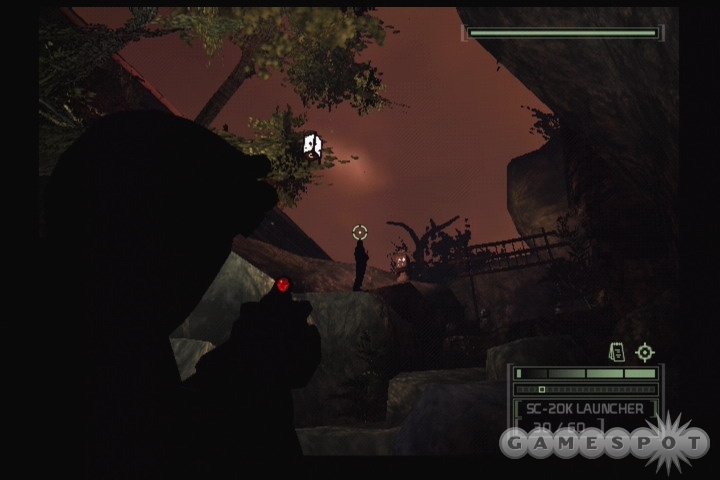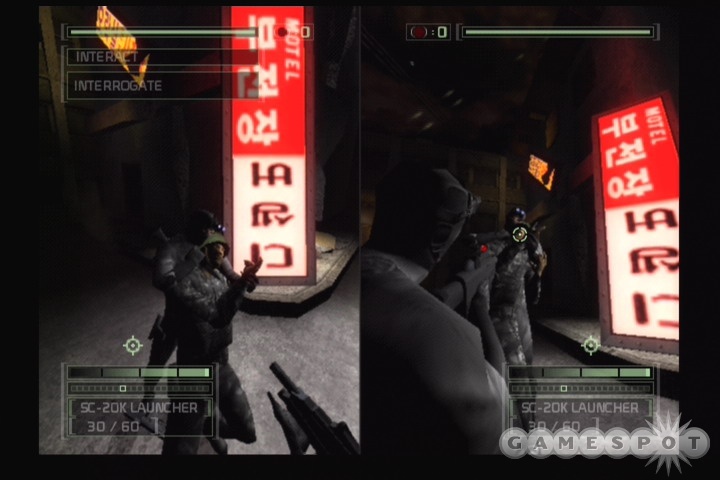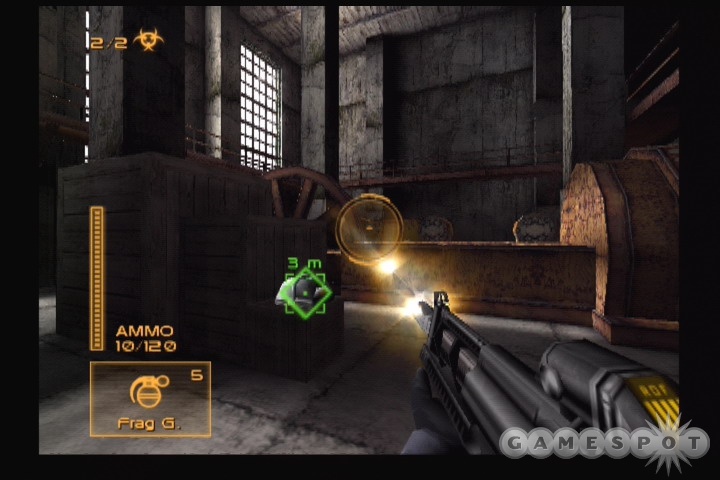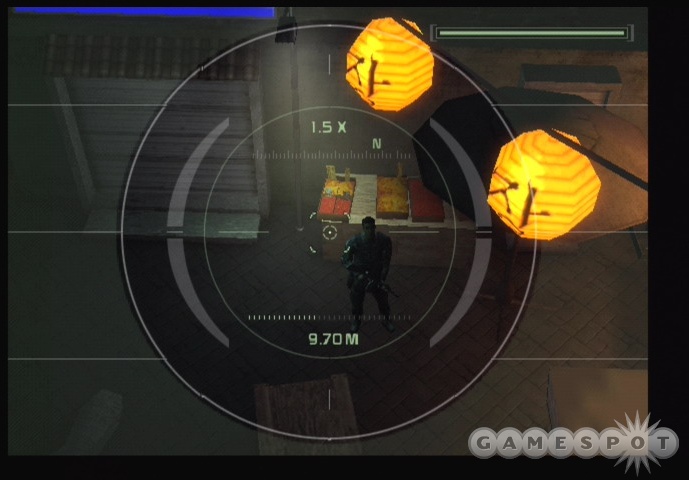The third iteration of the Tom Clancy's Splinter Cell stealth action franchise features the continuing adventures of Sam Fisher, a top secret agent who's sent in to accomplish the US government's dirty work when political situations go sour. It's also got a brand-new two-player cooperative mode, in addition to an updated version of the innovative spies-versus-mercenaries competitive multiplayer mode introduced in the second Splinter Cell game. So there's a lot to it, especially for Splinter Cell fans who felt a little too restricted while playing as Fisher in the previous games. With that said, Chaos Theory sometimes has a designed-by-committee feel due to its many disparate parts, and despite the game's grittier new theme and its new "Mature" rating, it's going to offer a familiar experience to Splinter Cell veterans. The PlayStation 2 version of the game is also much, much worse than the Xbox and PC versions of the game. Strictly on its own merits, this version is a good but unimpressive action adventure that still smacks of being a watered-down port of a technically superior game.

Though the competitive multiplayer mode and new cooperative campaign are the most original aspects of Chaos Theory, the solo campaign is the highlight. It's once again composed of a linear series of missions, but these are generally somewhat bigger, more open-ended, and more fun than those of the previous games. Set in the near future, the campaign focuses on the threat of informational warfare and a tenuous relationship between the United States, North Korea, and Japan. Enter Sam Fisher, who's summoned to various international hot spots to find the truth, and possibly to silence certain dangerous individuals. You'll control him from a third-person perspective as he infiltrates enemy compounds and ventilates his foes.
Though the premise of the story is a techno-thriller that lives up to the Tom Clancy name, storytelling has never been Splinter Cell's strong suit, and Chaos Theory is no exception. Some unfocused between-mission cutscenes sometimes set the stage for your next assignment, but a lot of your mission details are conveyed in boring, easily skippable premission monologues by your commanding officers and informants. Unsurprisingly, the best parts of the story happen during the missions themselves, where you'll often hear Fisher exchanging banter with his off-site crew. Fisher, once again brought to life by gravelly voiced actor Michael Ironside (Total Recall, Starship Troopers), is a great character, thanks to his dry, melancholy sense of humor. But the game sometimes tries too hard to be clever, with a few highly conspicuous attempts at self-referential jokes. At any rate, you shouldn't play this game for the plot--you should play it because no other game does this well at making you feel like a deadly spy working behind enemy lines.
Fisher is deadlier than ever this time around, thanks partly to his new combat knife, which he has inexplicably started using since his last assignment. The knife is mostly just a cosmetic change from the previous Splinter Cells, since in those games Fisher could put his opponents into a choke hold, whereas he now holds them at knifepoint (bold new look, same difference). Even though he threatens his captives with a knife to their throats, Fisher can't actually cut them once he's grabbed them from behind. He can either choke them to unconsciousness or deliver a fatal knee strike to their lower back. Prior to grabbing them, he can now also stab his foes to death quickly, quietly, and, for some reason, bloodlessly. And though he's replaced his old elbow smash with a palm strike or a punch to the temple, he can optionally still knock his foes unconscious as opposed to killing them outright.

One of the reasons Chaos Theory is easier than its predecessors is because Fisher's melee attacks are more effective, allowing him to reliably eliminate foes with a single swift attack, without even resorting to using his guns. There's actually no difference in gameplay terms between killing a foe and knocking him out. It's nice to have the choice for variety's sake, but the options could have been more meaningful. At any rate, it's good to see a bunch of great, new animations in the game. Fisher has always moved with incredibly lifelike grace, but he looks even better in action now. Probably the best of the new animations is how, when Fisher is creeping near to an unaware opponent, he'll naturally shift his weight away from the foe, putting as much distance between the two of them as he possibly can. It's a subtle effect that really makes you feel like you're stalking your foes in the darkness.
Fisher's got a bunch of other surprising new moves here, some of which are possible thanks to the knife, and others that allow him to take out his foes in interesting new ways. However, you won't get to use new moves often. You'll instead end up using the same sorts of techniques that were central to the first two Splinter Cell games. You'll frequently shoot out lights, switching to your night vision or thermal vision to aid you while your foes stumble blind. You'll also frequently creep up on foes from behind and consider shooting them in the head, using either your pistol or your newly redesigned SC-20K multipurpose assault rifle. You'll also get to pick locks, hack into computers, crawl through air ducts and other tight spots, slip past security cameras, and more.
So, what's so different about Chaos Theory's campaign if you're doing the same sort of stuff as before? It's that the campaign is much more open-ended now. This latest Splinter Cell generally gives you a lot more freedom to pursue your objectives by any means necessary. For example, when faced with a locked door, you don't strictly need to have the key code to get through it anymore--you can now hack the electronic lock or simply break the lock with your knife. The variety is good to have, though it highlights that the third installment in the series still makes use of its predecessors' utilitarian system that lets you choose context-sensitive actions like "switch object" and "grab character" from a text menu, rather than let you perform these actions more intuitively. Also, your pistol now has a secondary firing mode, which can temporarily disable electronics--useful for creating darkness as well as distraction. And whereas many of the older Splinter Cell missions ended in an automatic failure if you sounded an alarm too many times (something that Chaos Theory pokes fun at early on), most of the missions this time don't restrict you like that, nor do they force you to hide enemies' bodies or spare their lives. As mentioned, missions also have optional objectives and sometimes multiple paths to the main objectives. You can even go into each mission with a different arsenal, suited either for stealth, assault, or a balanced combination of the two, though your choice probably won't have a major impact on how you play.

All of this allows you to improvise while playing Chaos Theory, rather than going through a trial-and-error process until you figure out the "right" way to proceed. That's a real improvement, though it literally means you can approach most of the game's missions much more carelessly than you could in previous Splinter Cells. In fact, outside of a few specific sequences, Splinter Cell vets will find the campaign to be a walk in the park at the normal difficulty. Still, if you want a more-meticulous challenge, the game offers multiple difficulty settings, the tougher of which are more punishing of tactical errors by making Fisher much more vulnerable to enemy fire.
The international settings of Fisher's escapades are a major highlight on the Xbox and PC, but on the PS2, the settings lack detail and look not just bland but dismally, oppressively dark, diminishing what should have been one of the most appealing aspects of the game. A fairly useful map is always there to help guide you to your next objective, but the missions are designed in a linear fashion that tends to prevent you from getting lost, and not at the expense of seeming overly simple or straightforward. The enemies you'll face in Chaos Theory are also somewhat smarter, or at least different, than before. They'll notice if the lights go out or if a door is left ajar, and they will wander over to investigate. And, if you try to snipe them and miss, they'll flinch believably or maybe even dive out of the line of fire. They'll attack you from behind cover, and they are dangerous in numbers. Most of them are still completely unable to see you when it's dark, so it's really not that hard to quietly creep up behind or around them. But getting to see your foes' new tricks, and coming up with new and interesting ways of distracting them or luring them to you, is definitely part of the fun.
The campaign is close to 10 hours long, and it ends dramatically but abruptly. The several difficulty options, optional objectives, and relatively free-form gameplay make it more replayable than the previous Splinter Cell campaigns. Of course, you've got other modes competing for your attention, like the new cooperative mode. This mode is endearing, considering co-op modes are grossly underrepresented in today's games, and considering that Chaos Theory's implementation lets you and your partner perform a whole bunch of cool moves that one spy alone couldn't accomplish. For example, one spy can toss his partner over high walls or across chasms, and they may act like human ladders for one another, too. These different co-op moves look great, but they're executed in very specific locations and situations, so their implementation feels somewhat contrived.

Beyond that, co-op Chaos Theory plays just like the campaign, except with two players running around instead of one. Coordinating attacks with a friend can be a lot of fun. The thing is, Chaos Theory includes just four co-op missions (plus a training mission that does little but showcase the various co-op moves you can do), and the one set in Seoul is by far the best. It ties in with the main campaign's storyline and is tightly structured and altogether exciting. The other co-op missions feel a lot bigger and emptier, and they suffer for it. For some reason, you don't have access to a map in co-op, nor is there any easy way to tell where your partner is if you get separated. As such, the co-op missions can devolve into the two of you wandering around, looking for where to go next or looking for each other. All in all, cooperative Chaos Theory is a great concept that's fairly well executed, but you can tell that more effort went into the single-player campaign than into the handful of derivative co-op missions. Also, the co-op mode on the PS2 is playable only in a split-screen, and it suffers from a shoddy frame rate and heavy aliasing. In other words, it looks pretty bad. For some strange reason, the co-op missions themselves are also presented out of order, as compared with the other versions of the game.
Then there's the four-player versus mode. Last year's Splinter Cell Pandora Tomorrow introduced the whole spies-versus-mercenaries multiplayer concept to Splinter Cell, and it was one of the most innovative multiplayer games of the year. Chaos Theory's version of this multiplayer mode is basically the same thing, so fans will be able to dive right in while new players will have a lot to learn. Strangely enough, the PS2 version of Chaos Theory is missing some of the advancements made in the Xbox and PC versions' multiplayer modes, namely the requirement of a training exam to get online, as well as the new "story" mode, which conflates all of Pandora Tomorrow's multiplayer modes into one objective-based mission type. At least most of the new maps are here. Those who played Pandora Tomorrow online know that the spies resemble Sam Fisher, but in Chaos Theory they have a distinctly different feel and some of their own unique moves. The mercenaries are controlled from a first-person viewpoint yet they are slower and more complicated to control than your typical FPS character. In addition, there's the fact that you need to learn the game's big, rather intimidating levels--about half of which are new, and half of which are updated versions of Pandora Tomorrow maps.
Pandora Tomorrow players will know that this multiplayer mode definitely captures the sense of having to hunt your prey. They'll also find that the Chaos Theory multiplayer mode for the PS2 is basically identical to that of the previous game, except for the new maps. Not only is the PS2 missing the Xbox and PC versions' objective-based mode, but also it seems to be missing the various new gadgets and gameplay tweaks added to the spy and mercenary sides.

Ultimately, the game's multiplayer mode is an acquired taste, and for better or worse, it caters to the hardcore. Many of the maps feel very big with the maximum of four players in them, and if you haven't learned every inch of the map, much less come to grips with the idiosyncrasies of the spy and mercenary sides, then you're potentially a huge liability to your teammate. This isn't necessarily a fun multiplayer game to play with strangers, and even if you play it with friends, expect to spend a lot more time searching for each other instead of fighting.
Splinter Cell's famous good looks have always helped the series a great deal, but don't expect to find that in Chaos Theory for the PS2. As mentioned, the game is so dark that it's hard to look at. The environments will constantly force you to toggle your night vision on and off just to get your bearings, and the game chugs along at a substandard frame rate. Fisher at least looks decent, though his foes lack much of the detail found in other versions of the game where you can see the look of terror in their eyes when you put them in a vice grip (here they just look stoic, like they've been there before). At least the multiplayer portion of the game still looks relatively good. But overall, this game's presentation is decidedly unflattering.
The audio is probably the one aspect of the game that didn't suffer much in translation to the PS2, though at times you'll still wish that it was implemented better. An original soundtrack by electronica artist Amon Tobin punctuates the campaign and the game's menus, lending a superspy feel to the proceedings whenever it chimes in. As in previous Splinter Cell games, the soundtrack's cues are actually a little haphazard. For example, you'll be skulking about without any background music for the most part, and then the beats suddenly kick in if you alert anyone to your presence or get in a fight. When the coast is clear, the music fades as quickly as it picks up, dampening some of the suspense you might otherwise experience if you weren't sure if other foes were nearby. The music sounds terrific, at any rate, as does the voice work from the game's main cast. Fearsomely loud gunfire and other well-done ambient effects help sell the whole experience, though the game's international cast of characters still speaks in stereotypically accented English. You'll also hear some of the characters' voices noticeably change as they go from chattering with each other to taunting you in a fight. It's not that bad, it's just something that can undermine some of your suspension of disbelief in a game that works hard to be convincing.

It's almost painful to directly compare the PS2 version of Chaos Theory to its Xbox and PC counterparts any further. For what it's worth, the PS2 version at least controls well, and like the other versions, it too includes a few too many unskippable splash screens, in-game advertisements, and undesirable loading times for comfort. The PS2 version also splits both the single-player and the co-op levels into discrete chunks, injecting even more loading times into the proceedings in the process. It's strange how this version of the game, despite having similar content to its counterparts on other platforms, could fare so much worse in practice. However, all these little things clearly add up to make it this way.
The design of Splinter Cell Chaos Theory's campaign fulfills a lot of the previously untapped potential of its predecessors' single-player portions, and the game's multiplayer options are certainly intriguing. On paper, it's got to be the most fully featured stealth action game to date, so if you like the idea of high-tech espionage, it's going to be appealing. The game's different ingredients do seem as if they were cobbled together, though, and Chaos Theory ultimately could have benefited from a greater sense of cohesion. And the many, many sacrifices made to the PlayStation 2 version of this game mean that it just can't be recommended in good conscience, despite being a good game if considered in a vacuum.